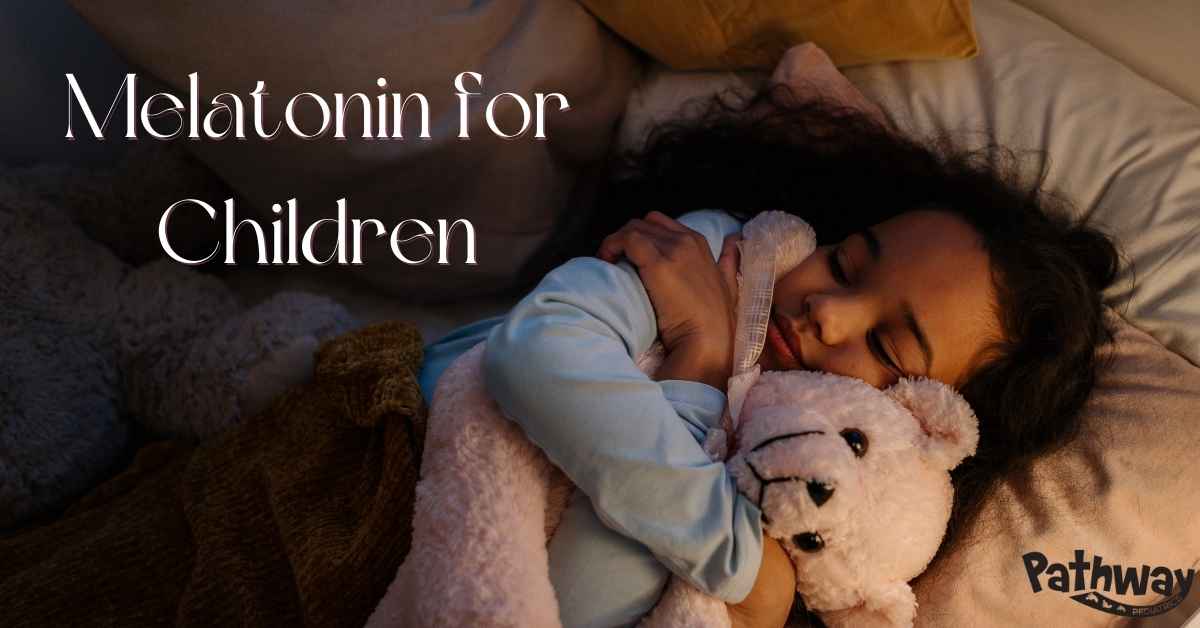Melatonin for Children
February 8, 2023

Melatonin has become a popular solution for insomnia in adults and children alike. It can be prescribed by a doctor, but it has become readily available in many forms over-the-counter and a quick solution for parents with restless children. But the use of melatonin for sleep is frequently misunderstood. How can you be sure you’re using it correctly?
What is Melatonin?
Melatonin is a hormone which is naturally produced by the pineal gland in your brain. Your body naturally raises your melatonin levels 1-3 hours before sleep and signals your body to the end the “wakefulness” signal produced by the circadian system and begin sleep.
Many parents turn to melatonin to help their children with sleep issues because it is naturally derived and perceived to be “safe”. But, frequent and unsupervised use of melatonin can cause problems. Although you cannot “overdose” on melatonin, it is a hormone with effects throughout the body and we do not yet know what the long-term effects of prolonged melatonin use are. In addition to unknown long-term effects, parents may forego implementing good sleep practices for the easier route of melatonin.
How Effective is Melatonin for Children?
The overall effects of melatonin for children include falling asleep more quickly and an increase in sleep time. Like all medicines used to help children fall asleep, there is fairly limited information available. This means that most studies have small groups followed for short periods of time. Furthermore, melatonin not regulated as a pharmaceutical in the U.S. Thus, there is no large pharmaceutical company bankrolling larger and long-term studies. Rather it is regulated as a food supplement by the FDA.
In children with chronic difficulty falling asleep, use of melatonin can result in less difficulty with falling asleep, earlier time of sleep onset, and more sleep at night. But its effectiveness varies and is effected by both dosage and timing. Keep in mind, melatonin does not affect every child the same and may not be as effective in one child as another.
What Can I Try Before Trying Melatonin?
Sleep training is the behavioral treatment for sleep problems in children and should be the first line of defense. Creating a consistent bedtime routine can fix sleep issues for many children. This includes:
- Establishing a consistent bedtime schedule
- Including positive activities around bedtime
- Keep the routine short (less than 45 mins.) and moving towards the bed (i.e., bathroom, bedroom, lights out in that order).
- Keep screens out of the bedroom as much as possible and avoid screen exposure for 30 minutes before bedtime.
If simple sleep training is not working, there are other tools parents can use before resorting to medication:
- Bedtime fading: temporarily moving your child’s bedtime later while teaching him to fall asleep on his own.
- “Cry it out”: an effective but challenging method for ignoring undesirable behavior where you complete the child’s normal bedtime routine, close the door, and let things play out. You can do this unmodified or graduated, with check-ins at regular intervals.
- Camping out: gradually withdrawing your presence from your child’s room at bedtime over an extended time (approx. 5-15 days)
- “Excuse Me” drill: where parents make up an excuse to leave the room (“I have to check on your brother, take out the trash, ect.) and return less and less frequently until the child is asleep.
Using Melatonin Correctly
If none of the behavioral treatments are working or your child has an additional behavioral or developmental issue that interferes with sleep, discuss using melatonin with your pediatrician. If they recommend it, make sure to follow their recommendations closely and only use the melatonin as prescribed.
Melatonin can be tricky to dose. Effects change depending on when you give it compared to you child’s usual sleep schedule. Because of this, a small dose a few hours before bedtime can be more effective than a large dose given at bedtime. Usually, giving it 30-60 minutes before the desired bedtime is best. You may also need to start with a smaller first dose and increase it incrementally over a few days. You should discuss all specific dosing information with your pediatrician before beginning a routine with melatonin.
If you are purchasing over the counter melatonin, make sure you are getting the best. Synthetic melatonin is preferred over the “all natural” that is derived from cow or pig brains. Try to look for a USP Verified product that is manufactured to meet requirements of the US Pharmacopeial Convention. These tend to have higher quality controls.
Remember: Melatonin is not a substitute for good sleep practices and should only be used alongside a good bedtime routine. The end goal is to help children sleep with a minimum use of medications and develop lasting good sleep habits. If you are concerned that your child’s sleep issues are related to other medical issues, consult your pediatrician before trying any treatments.
Next Post >>